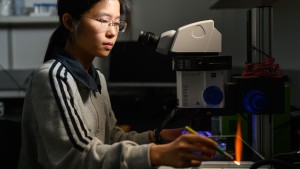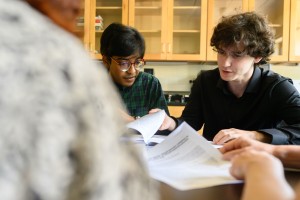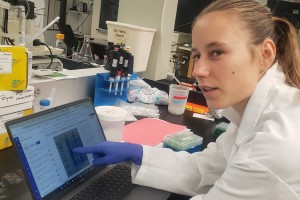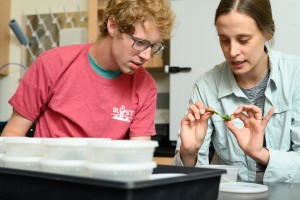“Slither” and “wiggle” would not be the right words for describing how the microscopic creatures in a Higley Hall lab move. Each one flaunts its pirouettes, submitting to melodies inaudible to the human ear.
C. elegans (full scientific name: Caenorhabditis elegans) is a transparent roundworm, barely 1 mm in size. A model organism of celebrity stature, it has played a key role in major advances, including those that led to the 2024 Nobel Prize in Physiology or Medicine. With a lifespan under 20 days, the worms share many disease-related genes with humans and are easy to raise, feed and monitor, compared to larger mammalian specimens.
This summer, they played a starring role in the work that Reina He ’26, a biology major, and Kudzaishe Mhere ’28, an aspiring neuroscience major, conducted in the lab of Peter Kropp, Harvey F. Lodish Faculty Development Chair in the Natural Sciences and assistant professor of biology.
The students used C. elegans with patient-specific mutations in the nfu-1 gene to investigate Multiple Mitochondrial Dysfunction Syndrome 1 (MMDS1), a rare and fatal disease affecting mitochondria, the energy-producing centers in cells. A neurodegenerative disorder, MMDS1 causes patients to suffer muscle weakness, seizures and severe feeding difficulties, resulting in infant mortality. By studying neuron impairment in the roundworms, the student researchers aim to understand how and why the neurons break down.
Together, He and Mhere examined how the mitochondrial disease’s impairment disrupts the worms’ movement and feeding behavior. Mhere, a Cascade Scholar, focused on whether the worm wants to eat, while He, a Summer Science Scholar, observed whether the worm can detect food. For the researchers, the complicated issue was reduced to a simple question: to eat or not to eat?
He spent the summer examining the worm’s chemosensory neurons, which allow it to smell and respond to food or repellant odors. “They use a ‘biased random walk,’” she explained. “If they sense more food, they turn less often and keep going that way. If they sense less, they turn more.” Through her observation, she recognized how mitochondrial dysfunction disrupts “smell” neurons affecting their ability to find food.
Mhere, whose interest in neurobiology blossomed in Zimbabwe, where he taught children with attention-deficit disorder, studied the mutated C. elegans’ gut-brain axis, where digestive neurons signal the brain. When the communication system became impaired, the worm would reject food right in front of it, a sign of lost appetite.
While He’s research zoomed in on specific neuron impairment, Mhere explored a systemic collapse and its implications. During one lab session, a live worm crawled over the carcass of a nearby worm, something they normally avoid to protect against infection. A chilling microcosm of their studies, the episode made it clear that the nfu-1 mutations completely disrupted the worm’s evolutionary purpose of survival.
The students’ research unravels how a single mutation can affect a patient’s olfactory sensory neurons and their digestive system before manifesting into fatal symptoms attached to MMSD-1. And it leads to even more important questions about what can be done to help.
“How can we reverse this condition?” Mhere asked. “Or maybe even apply it to human diseases?”
This article was written by Marisa Phoeung ’26 as part of the Hoskins Frame Summer Science Writing Scholars program.







